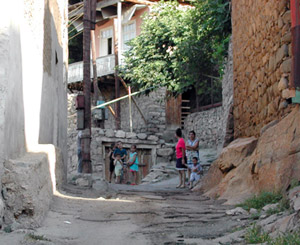Meghri is the South-end region of Armenia. Though it is not so large (644 square kilometers), however, it contains almost all the climatic zones: starting from torrid climate and ending up with Alpine climate. The centers of population are situated in territories of 600-1200 meters above sea level.
Most of the 12.000 citizens of this region are involved in agriculture, mostly in gardening. The fruit of Meghri is so tasty and sweet that it seems to correspond to the name of this region, which means sweet in Armenian.
At the end of the last century there were about 65 monuments in Meghri, which were unique due to their architecture and carvings. However, those carvings could not even be seen in churches. There are carvings on churches of the old and new parts of Meghri city made by the artists of the Hovnatanyan family.
A program of “reconstructing the economy of the South-end region of Armenia” was proposed to UNESCO with the purpose of protecting these unique monuments of Meghri. This program was supported and volunteers agreed to sponsor this program during the “Culture for Development” conference in 2001. The founder of this program, architect Armine Petrosyan, founded “Meghri-1” charitable NGO. It still operates and has implemented a lot of important projects. Its goal is not to keep the Armenian heritage alive, but to reconstruct those monuments and use them. Armine Petrosyan says that the most important thing is to protect the ethnic environment.
“Meghri-1” reconstructs the old houses of the “traditional” citizens of the old district with the purpose of using them for ethnic tourism in the future. Also, the city government of Meghri plays a key role in this process. Being a member of “Meghri-1”, the mayor of Meghri city Misha Hovhannisyan does his best to support this program. The reconstruction of the first house in the old district is sponsored by the Armenian “Izmirlyan” fund from Switzerland.
We presented the project at “Izmirlyan” fund two years ago. The executive director of the fund Jak Sargsyan accepted our application”,-says Armine Petrosyan. Armine Petrosyan thinks this is important, because Meghri is a remote city.
In order to ask someone to implement such programs in Meghri, first of all, one must explain to them what kind of place Meghri is, where it is, and why in Meghri exactly and not somewhere else. Being a remote region Meghri is already out of attention. I asked some colleagues how many times they had been to Meghri and it turned out that not one of them had been there. This kind of alienation was connected with the fact that it was close to the border before. During the soviet period people could visit Meghri only after getting an “entrance visa” to this territory issued by the Ministry of Internal Affairs. The passengers going by train (the route was via Nakhijevan) and buses were examined by the police so much that they would refuse to go there if it wasn’t for the nature.
All the regions of Armenia look different and not one looks like the other: Eghegnadzor differs from Lori much, Aragatsotn doesn’t look like the surroundings of Sevan, Sisian and Goris are quite different. Meghri contains the natural beauty of all these regions. There is everything here, and the will to see this natural beauty made people go there and forget about all the difficulties. Anyway, Meghri is out of any travel routes now. The main reason is that it is too far, but of course, the problem of hotels and other services are important too. One of the goals of “Meghri-1” is to develop substructures supporting tourism. Now they don’t need stones and other construction materials. First of all, they need to restore the traditional environment in the local houses.
The problem will not be solved even in case of reconstructing a house or several houses until people look differently at the changes.
“We have to make everything, including houses, trees, flowers and the environment in its entirity altogether. In this case everything will look like real, instead of artificial”,-says Armine Petrosyan.
Armine Petrosyan thinks that in the past, people have not tried to solve bigger problems. They built houses, made gardening and everything was harmonized without any hard work on the design. And these people became a part of this environment. The tourists visiting this place in the future will have a chance to see this environment themselves. Can you imagine? You are in Meghri for a couple of days, but you don’t stay at a hotel, but at someone’s place, where they treat you with fruit from their own garden and with home-made food. They tell you stories of their grandfathers, who used to live “in the same room of your hotel” long ago.
Armine Petrosyan thinks that in order to have this kind of environment, first of all, the citizens of Meghri should not consider the old district as a place just for living, but rather as an environment, where people, their life and culture coexist. “I want people to feel the difference after the reconstruction of this house. I want them to look at it differently so they can become a part of this environment”,-says Armine Petrosyan.
Her goal is to revive the culture of this place. This is done in many cities in Europe and people are interested in these kinds of environments and treatment of the people living there. Tourists usually visit museums, take tours to see monuments, etc. They usually stay at modern hotels, where the European design doesn’t impress them.
“For instance, I think that making wine or drying fruit is part of culture. I think that we must develop these things”,- says Armine Petrosyan. She is sure that this remote region can become an attractive site for tourism if it continues with this mentality.

